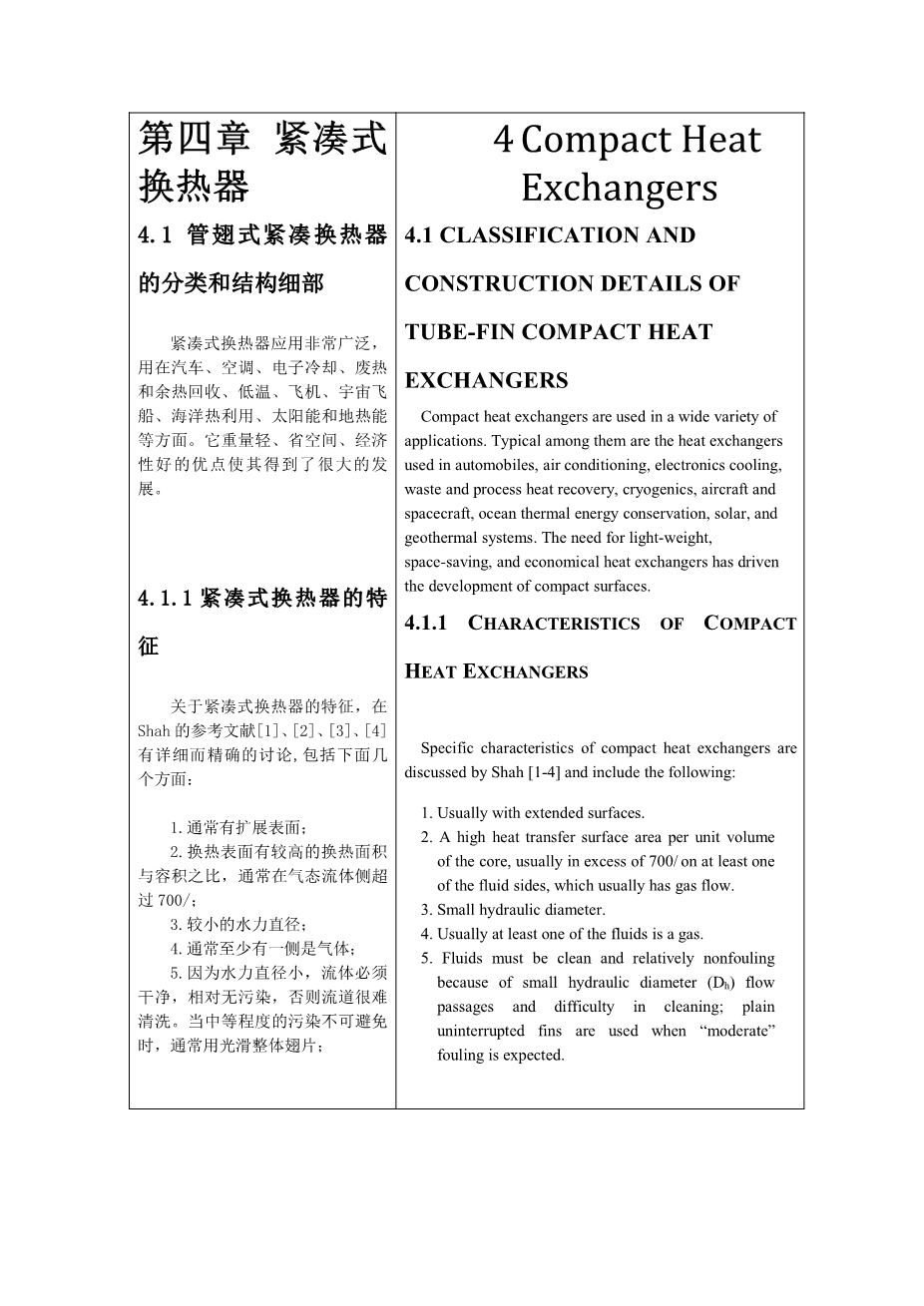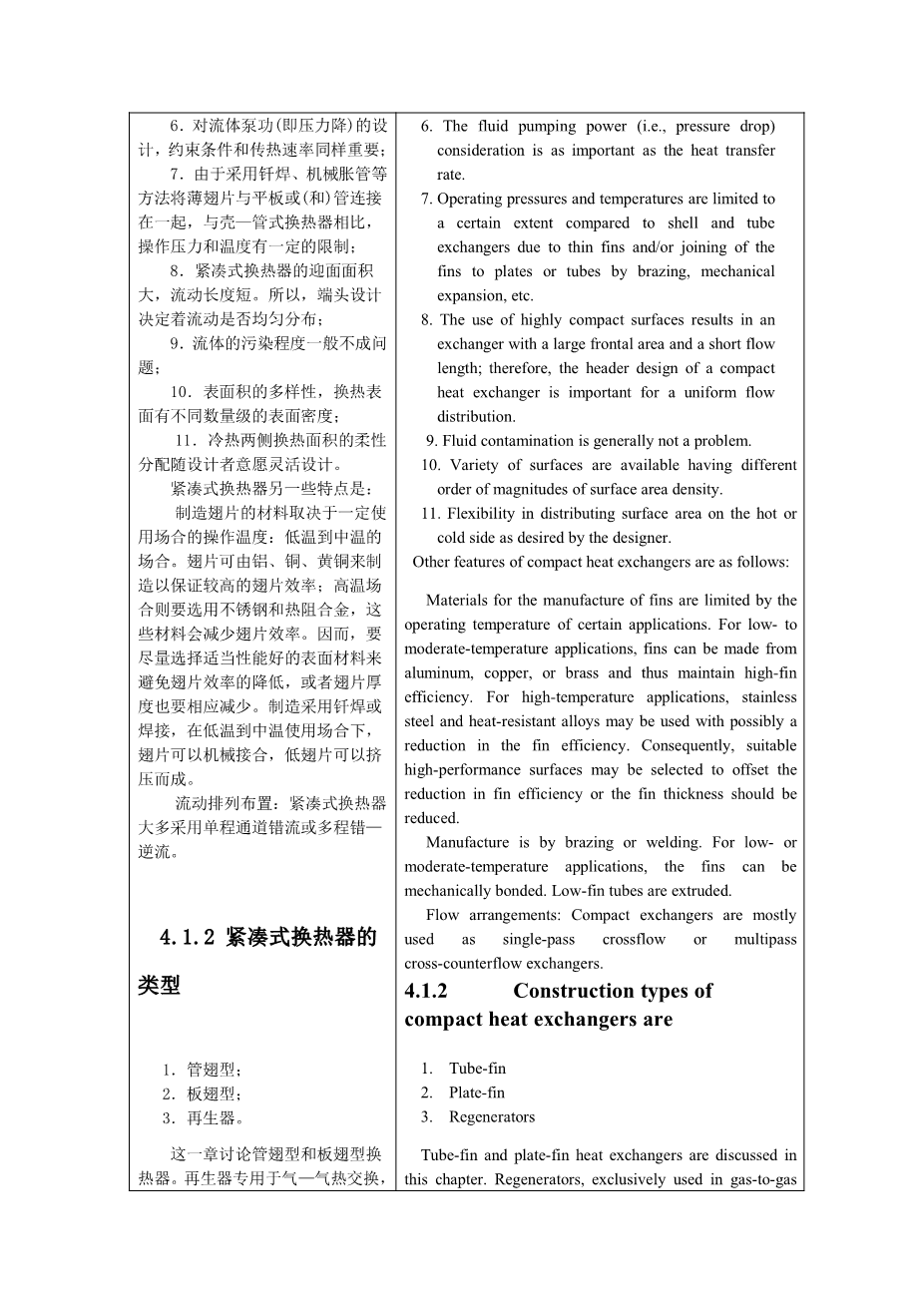- Compact Heat Exchangers
4.1 CLASSIFICATION AND CONSTRUCTION DETAILS OF TUBE-FIN COMPACT HEAT EXCHANGERS
Compact heat exchangers are used in a wide variety of applications. Typical among them are the heat exchangers used in automobiles, air conditioning, electronics cooling, waste and process heat recovery, cryogenics, aircraft and spacecraft, ocean thermal energy conservation, solar, and geo-thermal systems. The need for light-weight, space-saving, and economical heat exchangers has driven the development of compact surfaces.
4.1.1 Characteristics of Compact Heat Exchangers
Specific characteristics of compact heat exchangers are discussed by Shah [1-4] and include the following:
1. Usually with extended surfaces.
2. A high heat transfer surface area per unit volume of the core, usually in excess of 700 m[1]/m[2] on at least one of the fluid sides, which usually has gas flow.
3. Small hydraulic diameter.
4. Usually at least one of the fluids is a gas.
5. Fluids must be clean and relatively nonfouling because of small hydraulic diameter (Dh) flow passages and difficulty in cleaning; plain uninterrupted fins are used when “moderate” fouling is expected.
6. The fluid pumping power (i.e., pressure drop) consideration is as important as the heat transfer rate.
7. Operating pressures and temperatures are limited to a certain extent compared to shell and tube exchangers due to thin fins and/or joining of the fins to plates or tubes by brazing, mechanical expansion, etc.
8. The use of highly compact surfaces results in an exchanger with a large frontal area and a short flow length; therefore, the header design of a compact heat exchanger is important for a uniform flow distribution.
9. Fluid contamination is generally not a problem.
10. Variety of surfaces are available having different order of magnitudes of surface area density.
11. Flexibility in distributing surface area on the hot or cold side as desired by the designer.
Other features of compact heat exchangers are as follows:
Materials for the manufacture of fins are limited by the operating temperature of certain applica-tions. For low- to moderate-temperature applications, fins can be made from aluminum, copper, or brass and thus maintain high-fin efficiency. For high-temperature applications, stainless steel and heat-resistant alloys may be used with possibly a reduction in the fin efficiency. Consequently, suit-able high-performance surfaces may be selected to offset the reduction in fin efficiency or the fin thickness should be reduced.
Manufacture is by brazing or welding. For low- or moderate-temperature applications, the fins can be mechanically bonded. Low-fin tubes are extruded.
Flow arrangements: Compact exchangers are mostly used as single-pass crossflow or multipass cross-counterflow exchangers.
4.1.2 construction types of compact heat exchangers are
1. Tube-fin
2. Plate-fin
3. Regenerators
Tube-fin and plate-fin heat exchangers are discussed in this chapter. Regenerators, exclusively used in gas-to-gas applications, could have more compact surface area density compared to plate-fin or tube-fin surfaces. They are covered in detail in a separate chapter. The unique characteristics of compact extended-surface plate-fin and tube-fin exchangers that favor them as compared with the conventional shell and tube exchangers include the following [1,3,4]:
1. Many surfaces are available having different orders of magnitude of surface area density.
2. Flexibility in distributing surface area on the hot and cold sides as warranted by design considerations.
3. Generally substantial cost, weight, or volume savings.
The following factors mainly determine the choice among the three types of compact heat exchangers:
1. Operating pressure and temperature
2. Phases of the fluids dealt with
3. Fouling characteristics of the fluid
4. Allowable pressure drop
5. Strength and ruggedness
6. Restrictions on size and/or weight
7. Acceptable intermixing of the fluids dealt with
4.1.3 Tube-Fin Heat Exchangers
Tube-fin heat exchangers are widely used throughout the industry in a variety of applications. They are employed when one fluid stream is at a higher pressure and/or has a significantly higher heat transfer coefficient compared to the other fluid stream. For example, in a gas-to- liquid exchanger, the heat transfer coefficient on the liquid side is generally very high compared to the gas side. Fins are used on the gas side to increase surface area. In a tube-fin exchanger, round and rectangular tubes are most commonly used (although elliptical tubes are also used), and fins are employed either on the outside or on the inside, or on both sides of the tubes, depending upon the application. Fins on the outside of the tubes (Figure 4.1) may be catego-rized as follows:
1. Normal fins on individual tubes (Figure 4.1a), referred to as individually finned tubes.
2. Longitudinal fins on individual tubes (Figure 4.1b), which are generally used in condensing applications and for viscous fluids in double-pipe heat exchangers.
3. Flat or continuous (plain, wavy, or interrupted) external fins on an array of tubes (either circular or flat tube) as shown in Figure 4.1c,d. Since interrupted fins are more prone to fouling, many users prefer plain continuous fins in situations where fouling, particularly by fibrous matter, is a serious problem.
Compact Heat Exchangers
剩余内容已隐藏,支付完成后下载完整资料


英语原文共 30 页,剩余内容已隐藏,支付完成后下载完整资料
资料编号:[146154],资料为PDF文档或Word文档,PDF文档可免费转换为Word


